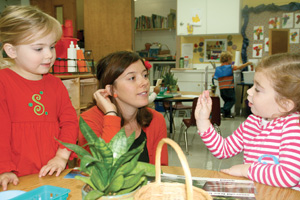Responsive Classsroom at Sayre: New Program Blends Character Building With Academics
 When Roberta Wykoff was hired as the new Director of Sayre’s Lower School two years ago, she brought with her 10 years of experience with the Responsive Classroom model of teaching.
When Roberta Wykoff was hired as the new Director of Sayre’s Lower School two years ago, she brought with her 10 years of experience with the Responsive Classroom model of teaching.
She knew instinctively that it was ideal for the Lower School at Sayre.
Developed by classroom teachers in 1981, Responsive Classroom emphasizes social and emotional growth of students as well as academics.
“The goal of the program,” said Wykoff, “is to create an environment and a culture of respect and understanding among the students and teachers.”
The program has 10 classroom practices, and the teachers at Sayre spent a week in August being trained in the first five with plans to implement the final five next year.
Each classroom day begins with the first of the practices – the Morning Meeting.
Students “circle up” as a group to greet each another, practice making eye contact, share news and warm up for the day ahead.
“I love it and the kids love it,” said Michele O’Rourke, a fourth-grade teacher at Sayre.
“It sets such a positive tone and is a great way for kids to start the day.”
Added Wykoff: “Learning these social skills helps kids to be successful in life.”
The second Responsive Classroom practice is Rule Creation where students devise the rules for the class.
O’Rourke calls it the “class constitution” and her fourth- graders are responsible for writing it and publishing it.
The third practice is Interactive Modeling that teaches children to notice and internalize expected behaviors.
For example, students review specific ways to pack up their belongings when transitioning from one class to another.
At Sayre, it’s called Pack, Stack and Move. Teachers model how students should calmly pack up their belong-ings, and the class practices it until it becomes routine.
Another Responsive Classroom practice emphasizes Positive Teacher Language. Instead of autocratic rules with a lot of “don’t do this, don’t do that,” teachers might start sentences with “What did you notice about…?” or “How can we solve this…?”
This gives students the chance to reflect on their behavior and develop problem-solving skills.
The fifth practice involves Logical Consequences for misbehavior.
Students are asked to work out an “apology of action” when they’ve hurt someone’s feelings.
Again, students participate in problem solving while developing invaluable social skills.
On the academic side, a study by the University of Virginia showed that math and reading scores improved among Responsive Classroom students.
Many Sayre parents enthusiastically support the new program.
“They are teaching the kids how to work together,” said Ann Stilz, mother of a Sayre second-grader.
“It brings out the best qualities in each person.”
Teaching children to communicate, to respect others and build self-confidence is often missing from our schools, she said.
“You can have all these academic degrees, but if you can’t communicate, you are in trouble,” Stilz said.
Wykoff has seen a change in the school as a whole, saying, “It’s so much calmer this year.”
That also improves teacher job satisfaction.
“It makes my classroom feel warm,” O’Rourke said.
She is especially fond of the Morning Meeting, as it helps her and the kids get to know each other better.
“Who wouldn’t love it?” she said. “We all take care of each other.”

